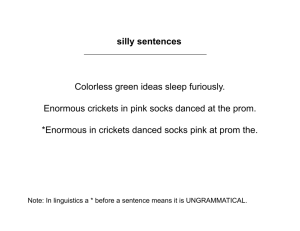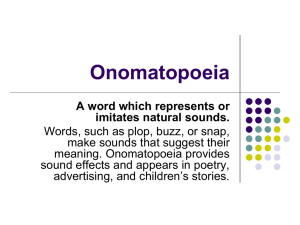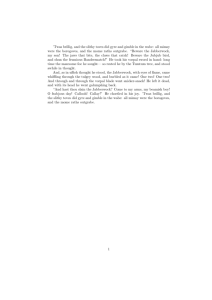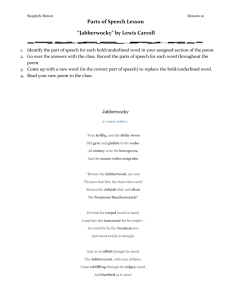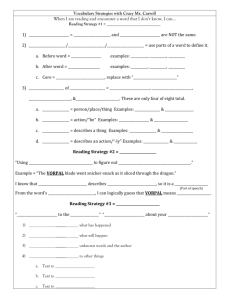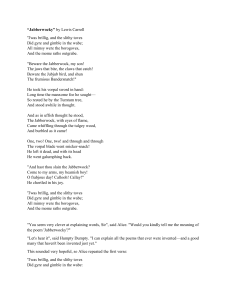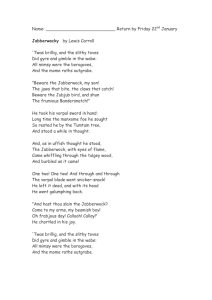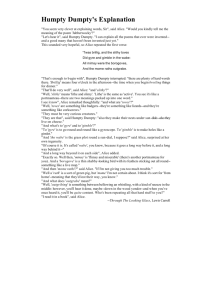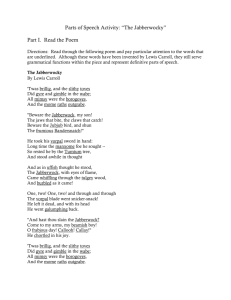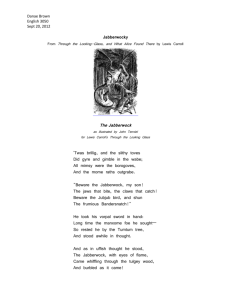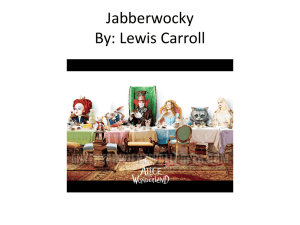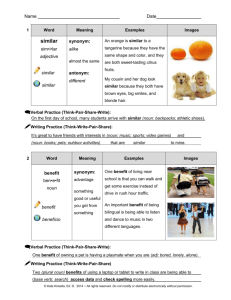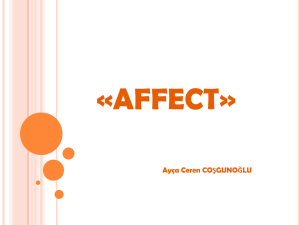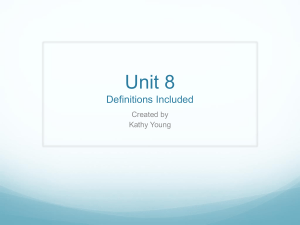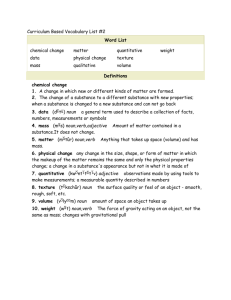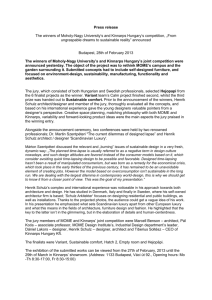Example: Jabberwocky Activity
advertisement
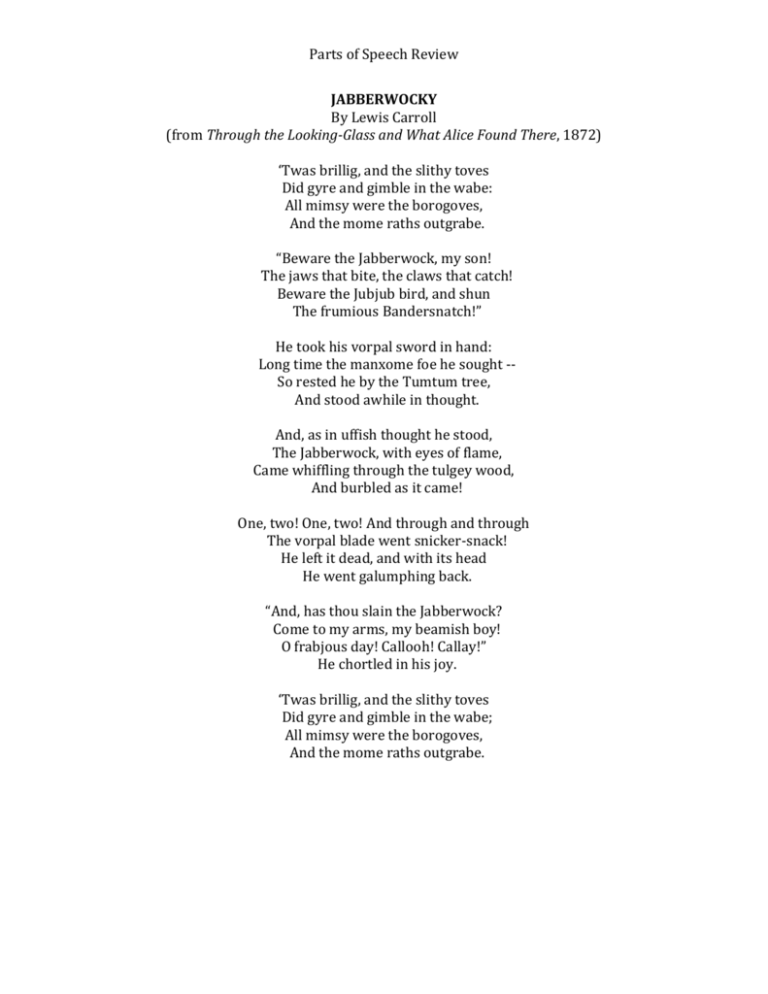
Parts of Speech Review JABBERWOCKY By Lewis Carroll (from Through the Looking-Glass and What Alice Found There, 1872) ‘Twas brillig, and the slithy toves Did gyre and gimble in the wabe: All mimsy were the borogoves, And the mome raths outgrabe. “Beware the Jabberwock, my son! The jaws that bite, the claws that catch! Beware the Jubjub bird, and shun The frumious Bandersnatch!” He took his vorpal sword in hand: Long time the manxome foe he sought -So rested he by the Tumtum tree, And stood awhile in thought. And, as in uffish thought he stood, The Jabberwock, with eyes of flame, Came whiffling through the tulgey wood, And burbled as it came! One, two! One, two! And through and through The vorpal blade went snicker-snack! He left it dead, and with its head He went galumphing back. “And, has thou slain the Jabberwock? Come to my arms, my beamish boy! O frabjous day! Callooh! Callay!” He chortled in his joy. ‘Twas brillig, and the slithy toves Did gyre and gimble in the wabe; All mimsy were the borogoves, And the mome raths outgrabe. Parts of Speech Review The Task… Although the strange words have no precise meaning, they seem to carry subtle overtones. In other words, Lewis Carroll used a lot of nonsense words, but you can still understand the story. With that in mind (and your knowledge of various parts of speech), you are going to go through the poem and label each word with its appropriate part of speech. Use the “Parts of Speech” review sheet if you need help (and also your pronoun notes!). Essentially, by using the words that you already know the “vague” meanings of and substituting new words for the nonsense ones, you should be able to figure out what part of speech each word is. For example, ‘Twas brilling and the slithy toves You know that “‘twas” means “it was,” “and” is a conjunction, and “the” is an article. We can guess that “brillig,” which refers back to “it,” is a pronoun. We also know “toves” is a noun because it is plural and because if a noun is put behind “the” it makes sense. Also, “slithy” must be an adjective because it is describing the word “toves.” We will review what you come up with as a class, so be prepared to share! Parts of Speech Review Article · the, a , or an Noun · a word that names something, such as a person, place, thing, quality, or idea i.e. man, city, school Proper Noun · a word that refers to a particular individual in a group or class i.e. Albert Lawson, Toledo, Central Cambria High School, Aunt Theresa Pronoun · a word that substitutes for a noun Personal Pronouns · substitute for definite persons or things i.e. I, you, he, she, it, we, they Demonstrative Pronouns · substitute for things being pointed out i.e. this, that, these, those Indefinite Pronouns · substitute for unknown or unspecified things i.e. each, either, neither, one, anyone, somebody, everything, all, few, many Possessive Pronouns · substitute for things that are possessed i.e. mine, yours, his, hers, its, ours, theirs Verb · a word that expresses action, existence, or occurrence by combining with a subject to make a statement, to ask a question, or to give a command i.e. She will paint the car. Adjective · a word that describes or limits a noun i.e. The small child left. Adverb · a word that modifies anything except a noun or a pronoun i.e. John performed well. I could barely hear the speaker. Hint: Answers the questions: How? When? Where? Parts of Speech Review A Jabberwocky Glossary There are two main sources to assist you in understanding the poem. One is Lewis Carroll himself. In one of a series of private little “periodicals” that young Carroll wrote, illustrated, and hand-lettered for the amusement of his siblings, he described a “curious fragment.” After a drawing of it, he proceeded to interpret some of the words. These explanations are listed below. The other source of explanations comes from Humpty Dumpty, whom Alice meets in Chapter VI of the book. He also provides explanations of some of the words -- not always the same as Carroll. These too are listed below. (*Definitions pulled from http://webpages.math.luc.edu/~vande/jabglossary.html) WORD brillig slithy tove gyre gimble wabe Carroll’s explanation Bryllyg (derived from the verb to bryl or broil). The time of broiling dinner, i.e. the close of the afternoon. Slythy (compounded of slimy and lithe). Smooth and active. Tove, a species of badger. They had smooth white hair, long hind legs, and short horns like a stag; lived chiefly on cheese. “Toves” should be pronounced to rhyme with “groves.” Gyre, verb (derived from gyaour or giaour, ‘a dog’). To scratch like a dog. Gymble (whence gimblet). To screw out holes in anything. Wabe (derived from the verb to swab or soak). The side of a hill (from its being soaked by the rain.) Humpty Dumpty’s explanation Four o'clock in the afternoon -- the time when you begin broiling things for dinner. Lithe and slimy. Lithe is the same as ‘active.’ ... It's like a portmanteau -there are two meanings packed up into one word. Something like badgers -they're something like lizards -- and they are something like corkscrews. ... They make their nests under sundials -- also they live on cheese. To go round and round like a gyroscope. To make holes like a gimlet. The grass plot round a sundial ... because it goes a long way before it, and a long way behind it ... and a long way beyond it on each side. Parts of Speech Review mimsy Mimsy (whence mimserable and miserable.) Unhappy. mome Flimsy and miserable. I'm not certain about mome. I think it's short for ‘from home’ -- meaning that they'd lost their way. A rath is a sort of green pig. Outgribing is something between bellowing and whistling, with a kind of sneeze in the middle. raths outgrabe borogoves Borogove. An extinct kind of parrot. They had no wings, beaks turned up, and made their nests under sundails; lived on veal. The first ‘o’ in ‘borogoves’ is pronounced like the ‘o’ in ‘worry.’ The word is commonly mispronounced as “borogroves” ... and this misspelling even appears in some American editions of the book. . A thin shabby-looking bird with its feathers sticking out all round -- something like a live mop.
